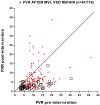Pulmonary hypertension caused by pulmonary venous hypertension
- PMID: 25610595
- PMCID: PMC4278619
- DOI: 10.1086/678471
Pulmonary hypertension caused by pulmonary venous hypertension
Abstract
The effect of pulmonary venous hypertension (PVH) on the pulmonary circulation is extraordinarily variable, ranging from no impact on pulmonary vascular resistance (PVR) to a marked increase. The reasons for this are unknown. Both acutely reversible pulmonary vasoconstriction and pathological remodeling (especially medial hypertrophy and intimal hyperplasia) account for increased PVR when present. The mechanisms involved in vasoconstriction and remodeling are not clearly defined, but increased wall stress, especially in small pulmonary arteries, presumably plays an important role. Myogenic contraction may account for increased vascular tone and also indirectly stimulate remodeling of the vessel wall. Increased wall stress may also directly cause smooth muscle growth, migration, and intimal hyperplasia. Even long-standing and severe pulmonary hypertension (PH) usually abates with elimination of PVH, but PVH-PH is an important clinical problem, especially because PVH due to left ventricular noncompliance lacks definitive therapy. The role of targeted PH therapy in patients with PVH-PH is unclear at this time. Most prospective studies indicate that these medications are not helpful or worse, but there is ample reason to think that a subset of patients with PVH-PH may benefit from phosphodiesterase inhibitors or other agents. A different approach to evaluating possible pharmacologic therapy for PVH-PH may be required to better define its possible utility.
Keywords: pulmonary hypertension; pulmonary venous hypertension.
Figures


References
-
- Arias-Stella J, Saldana M. The terminal portion of the pulmonary arterial tree in people native to high altitudes. Circulation 1963;28:915–925. - PubMed
Publication types
LinkOut - more resources
Full Text Sources
Other Literature Sources
Research Materials

